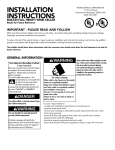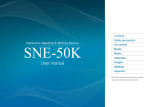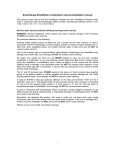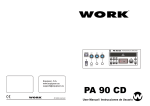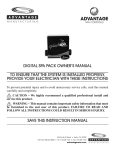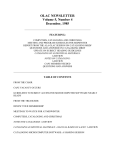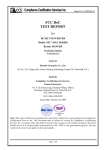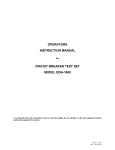Download Viking VCWB300 User's Manual
Transcript
SERVICE NOTEBOOK VCWB300 PROFESSONAL MODEL BUILT-IN FULL HEIGHT WINE COOLER Table of Contents Technical Information--------------------------------------------------------------------- 4 Sealed System------------------------------------------------------------------------------ 5 Control Panel Assembly------------------------------------------------------------------- 6 Mode of Operation------------------------------------------------------------------------ 6 Temperature Readout and Setting----------------------------------------------- 7 Display Off------------------------------------------------------------------------- 7 Compressor Protection------------------------------------------------------------ 7 Fan Operation---------------------------------------------------------------------- 7 Alarm Security--------------------------------------------------------------------- 8 Holiday Mode---------------------------------------------------------------------- 8 Service Mode----------------------------------------------------------------------- 8 Display Interface Board----------------------------------------------------------- 8 Glass Mullion Shelf---------------------------------------------------------------- 9 Electronic Function Description-------------------------------------------------------- 10 Display Panel Keyboard---------------------------------------------------------- 10 Power Disconnect Switch--------------------------------------------------------- 10 Showroom Switch----------------------------------------------------------------- 10 Display Panel Operation----------------------------------------------------------------- 11 Keyboard Entry Tone------------------------------------------------------------- 11 Zone Pad---------------------------------------------------------------------------- 11 Lower Temp Pad------------------------------------------------------------------- 11 Higher Temp Pad------------------------------------------------------------------ 11 Lights-------------------------------------------------------------------------------- 11 Display Pad------------------------------------------------------------------------- 12 Alarm-------------------------------------------------------------------------------- 12 Wine Cooler Leveling---------------------------------------------------------------------- 12 Door Stop Adjustment---------------------------------------------------------------------- 13 Hinge Adjustment--------------------------------------------------------------------------- 13 Diagnostic Check Points------------------------------------------------------------------ 14 E1 – Display Board Output------------------------------------------------------- 14 E2 – Touch Switch Inputs-------------------------------------------------------- 14 E3 – Outputs and Line Voltage Inputs------------------------------------------ 14 E4 – Thermistor Inputs------------------------------------------------------------ 15 Compressor Relay------------------------------------------------------------------ 15 Alarm Wires------------------------------------------------------------------------- 15 Display Board----------------------------------------------------------------------- 15 Compressor (General Information)-------------------------------------------------------- 16 Thermister Resistance Reading------------------------------------------------------------- 17 Solenoid Valve / Evaporator Fan----------------------------------------------------------- 18 Wiring Schematic---------------------------------------------------------------------------- 19 Wiring Diagram------------------------------------------------------------------------------ 20 3 VCWB300 DDWB300 DESIGNER – DFWB300 FULL OVERLAY BUILT-IN FULL HEIGHT WINE COOLER VIKING TECHNICAL INFORMATION * DUE TO POSSIBLITY OF PERSONAL INJURY OR PROPERTY DAMAGE, ALWAYS CONTACT AN AUTHORIZED TECHNICIAN FOR SERVICING OR REPAIR OF THIS WINE COOLER. The Viking Built-in Full Height 30” W. wine cooler (VCWB series) is designed to meet the needs of the upscale wine connoisseur while also meeting Viking Range Corporation’s stringent product standards. The product is 30” (76.2cm) wide and 84” (213.4cm) tall. The product has adjustable leveling legs to allow the height to be adjusted from 82 1/2” TO 84 3/4” (209.6 to2120.7cm). The sealed system is located on the top of the product. The product has commercial type construction and is available with various features and color options. General Specifications Model Internal Volume Capacity Electrical Requirements Maximum Amp Usage Refrigerant Type Refrigerant Charge Overall Width Overall Depth without Handle Includes Door Extrusions (Designer DDWB300) (Full Overlay DFWB300) Overall Height (Rollers to Top of Air Grille) VCWB300# 150 Bottles 115VAC, 60 HZ and 15 Amps 2.0 Amps HFC – 134a See Rating Label 30 inches (76.2cm) 24” 24 ½” 24 ¾” to Front of Grille 82 ½” to 83 ¾” 4 SEALED SYSTEM The sealed system consists of the following components (listed in order of refrigerant flow): 1 condenser coil 1 dryer assembly 3 solenoid valves 3 heat exchangers 3 evaporators 1 compressor 1 discharge tube 1 drain pan heater 1 pre-condenser loop Refrigerant Type – HFC 134a Refrigerant Charge – 7.3 oz. Evaporator Temperature Range 14°F to - 31°F Expanding Device – Cap tube Compressor Cooling: LBP 32° C Ambient temp 98 to 140V LBP 43° C Ambient temp 98 to 140V Maximum Condensing Pressures: Operating 230 psig Peak 293 psig Electrical Data: Normal Voltage 115VAC / 60Hz Start Winding Resistance – 21.20Ω (at 77°F) ± 8%. Run Winding Resistance – 7.90Ω (at 77°F) ± 8%. Locked Rotor Amps (60Hz) – 9.80 Amps. Full Load Amps (60Hz) – 1.20 Amps. 5 CONTROL PANEL ASSEMBLY The wine cooler is equipped with a control panel conveniently located in the top front of the top compartment of the wine cooler. From this point the user can operate all functions of the wine cooler’s temperature management and various electronic features. The control panel housing is constructed of injected molded plastic. A glass keyboard is fastened to the housing by means of snap clips that are incorporated into the molded housing. The keyboard is then secured in place with an adhesive. The keypad utilizes a special technology that senses mass. When the user places a finger on the glass surface at designated “button” locations the control recognizes this and converts this to an electronic signal. This signal is then processed by the wine cooler’s control that promptly results in a change of temperature settings or some of the other wine cooler electronic features. On the underside of the control panel a means for attaching two light bulbs is molded in place. The light tubes are installed into a separate lamp holder, which is then attached to the control panel by four “molded in” clips and four screws. Mode of operation: Microprocessor based 3 – channel temperature / logic control. Normal cooling operation: Control will independently read and regulate the average temperatures of each chamber to its corresponding set point as shown on the vacuum florescent display (“VFD”). When cooling is called for, the zone valve will energize and the compressor will energize 60 seconds later. Only one zone valve / fan can be energized at a time. Chamber 1 will take precedence over chamber 2, which will take precedence over chamber 3 in the event that more than one chamber is calling for cooling at the same time. Each chamber will run for a maximum of 10 minutes after which it will switch to the next chamber requiring cooling. When a chamber reaches 1º below set temperature the zone valve is de-energized. The control will energize the compressor 6 and appropriate zone valve based upon the temperature at the evaporator thermistor and will turn off the zone valve based upon the temperature at the chamber thermistor. Temperature readout and setting: Pressing the zone button will change which chamber is selected for adjustments. The selected chamber will have a bar displayed over the temperature reading on the VFD. Pressing the higher or lower buttons will raise or lower the set point of the selected chamber in one degree F increments. Every time any set point is changed a “set time” delay will start. When the “set time” delay is completed without another change in the temperature the currently displayed number will become the new set point. The new set point will be stored in non-volatile memory. The unit will begin controlling the particular chamber to the new set point, and the actual chamber temperature will be displayed. Temperature can be displayed in either Degrees F (default) or in Degrees C. It can be changed from one to the other by pressing and holding both the display on/off and the display alarm buttons simultaneously for 5 seconds. The display will show “F” or “C” appropriately. This setting will be stored in non-volatile memory and will be saved during period of power loss. Display off: To turn the display off, momentarily press the display. The display will turn off as soon as the button is released. To turn the display on, momentarily press the display button. The display will turn on as soon as the button is released. Compressor protection: At any time the compressor needs to start, including that power up the appropriate zone valve will energize for 60 seconds before the compressor is allowed to start. This is intended to allow to discharge any pressures in the system so that the compressor will not start under heavy load. Any time that all chambers reach set temperatures(s), the compressor will continue to run for an additional 30 seconds. This is intended to reduce compressor start / stop cycles as the various chambers call for cooling. Fan operation: The evaporator fans, if running will shut off whenever the door switch opens and turns back on when the door switch closes. When operating in Holiday Mode the Fan(s) will not turn off, if running, when the door switch opens. Chamber lighting: The light inside the chambers can be always on, or only on when the door switch is open. Pressing the lights button on the front panel toggles this setting. Also see holiday mode. Alarm security: Alarm operation can be toggled on or off by pressing the alarm front panel button for 2 seconds. When the temperature inside any chamber is higher than the set temperature by more than 5 degrees F for longer than the “2 hours” delay, the display will flash on and off and an audible signal will sound. When the alarm mode is active, an enunciator will appear in the display. Upon initial power-up, the alarm will be disabled for a start-up delay to allow for the unit to reach temperature. The alarm can be disabled by pressing the alarm off button. A door alarm is provided that will sound if the door switch is open for longer than the door alarm delay. The alarm will shut off upon reclosing the door and the delay time will be reset. Temperature alarm operation will be inhibited in show room mode. Home security contacts will transfer during an alarm condition. When operating in Holiday Mode, the high temperature alarm and door alarms are disabled. 7 Showroom mode: This mode, selected by closing the showroom switch is intended to simulate normal operation in all ways except the cooling and temperature alarm functions. Closure of this switch will over-ride normal cooling. Temperature displayed for the chambers will be the last temperatures stored in memory, or the factory defaults setting if they have not been changed. Lights and functions will occur as in normal cooling operation described above. Holiday mode (Sabbath mode): Pressing and holding the display button continuously for 10 seconds accesses this mode. (Note: The Display must be “on” before entering Holiday Mode.) To cancel Holiday Mode, press and hold the display button continuously for 10 seconds. When Holiday Mode is selected, a random time delay of 15 to 25 seconds will be applied to the compressor relay start and stop. The chamber lights relay will remain de-energized. The display will not be illuminated. Audible sound (beep) from the control will be disabled. Fan outputs will not be affected by opening or closing of the door switch. All front panel buttons will be inoperative except a 10 second press of the display button causing the control to exit Holiday Mode. All other functions will continue as in normal cooling described above. The Alarm sounds is disabled and the home security relay will not transfer. Service mode: This mode, selected by pressing and holding zone, higher temp and lights buttons simultaneously for 5 seconds is intended for manual operation of the compressor, valves and fans for purposed of servicing / diagnosing and repair. When put in to this mode, valve 1 will energize for 10 seconds to relieve any pressures in the system. The compressor will then energize and continue to run continuously while in service mode. Pressing the zone button will change which chamber is active as indicated on the display. The solenoid valve and evaporator fan will energize in the chamber that is active. To leave the service mode, press and hold the zone higher temperature and lights buttons simultaneously for 5 seconds, normal operation will then resume. Charge mode: Pressing the lower temp button while in service mode selects charge mode. In this mode all zone valves are open and all other functions are “off”. This is to vacuum, evacuate and charge the sealed system. To exit charge mode the power must be removed, turn “off” the power switch or unplug the product. Display interface board: Mode of operation: Interface board for Vacuum fluorescent display module. During normal operation, temperatures in all three chambers are displayed and the red lens is blinking approximately once per second when the RS-232 signal is being received. A “bar” symbol is displayed over the “active” temperature reading. The “adjusted” temperature will be displayed as blinking, approximately .5 seconds on .5 seconds off. When the “alarm mode enabled” signal is being received the “alarm” symbol will be displayed. If the “alarm” signal is being received, the “alarm” word will be displayed for approximately 4 seconds and the chamber temperature will be displayed for the next 4 seconds. The piezoelectric sounder will turn on for 100 milliseconds, approximately every 8 seconds. The display will be on, even if the “display blank” command is being received. 8 GLASS MULLION SHELF Each compartment is separated be a fixed glass shelf (“Mullion” – two per wine cooler). These glass shelves are uniquely designed such that they act not only as an insulated divider wall, but also provides a means of draining the condensate water from the top and middle compartments and as a means of attaching and supporting the light tubes for the middle compartment. The bottom trim of the shelf has holes for mounting the assembly to the cabinet of the wine cooler. This is accomplished through the use of “L” brackets that are attached to the liner walls of the cabinet and then attached to the shelf at an angle of 90° with respect to the walls of the wine cooler. Two of these “L” brackets are used: one on each side. The condensate drain nozzle is tapered so that a drain tube can be interference free onto the outer diameter of the nozzle. The drain tube directs condensate water to a desired location. For the top compartment, the tube directs water to the middle compartments mullion drain sump. For the middle compartment, the drain tube directs water to the sump in the liner bottom. Each mullion shelf has two “flanges” and two screw bosses located at the front bottom of the device. The two light tubes for the middle compartment are snapped into the flanges at each end and are then secured in place at each end with a screw and a light tube clamp. The wires for the light tubes are then routed along the left side of the shelf and secured and covered with an extruded wire channel. 9 DISPLAY PANEL KEYBOARD ELECTRONIC FUNCTION DESCRIPTION Power Disconnect Switch: The power on/off switch is used to turn the power off to the wine cooler when cleaning it or changing the light tubes. The wine cooler is shipped with the power on/off switch in the on position. To turn the power off, remove the center grille assembly by grasping the three center louvers, lifting up and pulling outward. Press the power on/off switch to the “ON” position. Replace the center grille assembly by aligning the hooks in the assembly with the slots in the brackets which are attached to the grille. Push in over the hooks and slide grille assembly downward. Showroom Switch: The showroom switch allows electronic controls and interior lights to function independently of the refrigeration system. Your wine cooler is shipped with the showroom switch in the “OFF” position. To use the showroom mode, remove center grille assembly and turn the showroom switch to the “ON” position. Showroom mode will be engaged. 10 DISPLAY PANEL OPERATION Keyboard Entry Tone Zone Pad Indicates a pad was pressed, command read and accept. 1. Toggle between zones for set point temperature adjustment. Pressing immediately toggles from Top to mid to bottom, respectively that order. Entry tone will sound at each depression of pad. 2. Used in conjunction with “Higher Temp” and “Lights” pads to enter service mode. Press “Zone”, “Higher Temp” and “Lights” simultaneously for 5 seconds to activate service mode. 3. Used in conjunction with “Higher Temp” and “Lights” pads to exit service mode. Press “Zone”, and “Lights” simultaneously for 5 seconds to exit service mode. Normal operation will then resume. 4. In service mode toggles between zones. Pressing immediately toggles from Top to mid to bottom respectively that order. Lower Temp Pad 1. Lowers Temperature settings in 1 degree increments. Entry tone will sound at each depression of pad until desired temperature setting is achieved. 2. Activates charge mode – Press lower temp pad when in “service mode” to activate charge mode. Higher Temp Pad Raises temperature settings in 1 degree increments. Entry tone will sound at each depression of pad until desired temperature setting is achieved. 1. Used in conjunction with “Zone” and “Lights” pads to enter service mode. Press “Zone”, Higher Temp” and “Lights” simultaneously for 5 seconds to activate service mode. 2. Used in conjunction with “Zone” and “Lights” pad to exit service mode. Press “Zone”, “Higher Temp” and “Lights” simultaneously for 5 second to exit service mode. Normal operation will then resume. Lights Toggle between lights on when door open only and lights always on. Warning: May affect temp regulation of Wine Cooler. Entry tone will sound at each depression of pad. 1. Used in conjunction with “Zone” and “Higher Temp” pads to enter service mode. Press “Zone”, Higher Temp” and “Lights” simultaneously for 5 seconds to activate service mode. 2. Used in conjunction with “Zone” and “Higher Temp” pads to exit service mode. Press “Zone”, “Higher Temp” and “Lights” simultaneously for 5 seconds to exit service mode. Normal operation will then resume. 11 Display Pad 1. Activates control panel. Pressing button for 2 seconds toggles the display on/off. Entry tone will sound at after 2 seconds of pad depression. 2. Activates Holiday Mode. Pressing button for 15 seconds toggles the holiday mode on/off. 3. Used in conjunction with “alarm” pad to toggle between “F” Fahrenheit and “C” Celsius temperature reading. Press and hold “Alarm” and “Display simultaneously for 10 seconds to change from one to the other (“F” or “C”) 4. Used in conjunction with “Alarm” button, temperature can be displayed in either Deg F (default) or in Deg C. It can be changed from one to the other by pressing and holding both the “Display” and the “Alarm” buttons simultaneously for 5 seconds. The display will show “F” or “C”. Alarm Toggles between alarm on and off. By pressing the alarm pad for 2 seconds. 1. Activates alarm feature. 2. Deactivates alarm feature. 3. Disables alarm in the event of a high temperature condition. 4. Used in conjunction with “Display” button temperature can be displayed in either Deg F or in Deg C. It can be changed from one to the other by pressing and holding both the “Display” and the “Alarm” buttons simultaneously for 5 seconds. The display will show “F” or “C”. Wine Cooler Leveling: A. Lift the wine cooler off the rollers, adjust to the desired height and level wine cooler by using a 5/16” hex head wrench. (Refer to Figure at the right). 1. To raise right side rear, rotate the right side rear hex rod Clockwise. 2. To raise the left side rear, rotate the left side rear hex rod Clockwise. 3. To raise the right side front, rotate the right side front hex rod Clockwise. 4. To raise the left side front, rotate the left side front rod Clockwise. NOTE: DO NOT use an electric driving device. Over tightening can cause damage. B. Align wine cooler with sides of cabinets by adjusting leveling legs. Rotate leveling legs until firmly in place against floor. C. To secure wine cooler, raise until compartment cover is firmly seated under the soffit or anti-tip boards. 12 LEVELING ADJUSTMENTS DOOR STOP ADJUSTMENT 1. 2. Using a 3/16” allen wrench, remove door stop pin located in bottom hinge. The pin is factory set 110°. For 120° swing, move the pin to the utmost forward stop hole. For 90° swing, move the pin to the utmost rear stop hole. HINGE ADJUSTMENT 1. 2. 3. Using 3/16” allen wrench, remove the door stop pin located in bottom hinge. Using the height adjustment shim as a wrenching device, rotate the height adjustment bushing counterclockwise to raise or clockwise to lower the location of the door. When proper adjustment is reached, align shim with door stop pin holes and replace door stop pin. Firmly tighten pin in place. 13 DIAGNOSTIC CHECK POINTS (Rfer to Wiring Schematic on Page 19) Number DescriptionA E1 1 2 3 Display Board Send +5Vdc data signals ground 1 2 3 4 5 6 7 8 9 10 11 12 Touch switch inputs (with switches connected), typical +5VDC Ground Common for measurements on E2 Not connected When button is touched +4Vdc to +5Vdc, otherwise less than +1Vdc. When button is touched +4Vdc to +5Vdc, otherwise less than +1Vdc. When button is touched +4Vdc to +5Vdc, otherwise less than +1Vdc. +5Vdc Ground Common for measurements on E2. Not connected. When button is touched +4Vdc to +5Vdc, otherwise less than +1Vdc. When button is touched +4Vdc to +5Vdc, otherwise less than +1Vdc. When button is touched +4Vdc to +5Vdc, otherwise less than +1Vdc. E2 E3 1 2–7 8 9 10 11 12 13 14 15 16 Outputs and line voltage inputs (loads connected) typical. Showroom switch off = 0V, on = 120VAC Not connected. Door switch open = 0V, closed = 120VAC. When Zone* is being cooled or service mode = 115 VAC , off = 0V When Zone* is being cooled or service mode = 115 VAC , off = 0V When Zone* is being cooled or service mode = 115 VAC , off = 0V When zone** is being cooled or service mode = 115 VAC , off = 0V When zone** is being cooled or service mode = 115 VAC , off = 0V When zone** is being cooled or service mode = 115 VAC , off = 0V When zone* lights to be on = 115 VAC , off = 0V Power line neutral. Common for all E3 measurements. * E3 pin 9 Solenoid #1 / pin 10 Solenoid #2 / pin 11 Solenoid #3 ** E3 pin 12 Evap. Fan #1 / pin 13 Evap. Fan #2 / pin 12 Evap. Fan #3. NOTE: All wiring controlling Fan #3, Sol #3, and both #3 Thermisters have Black strips. All wiring controlling Fan #2, Sol #2 and both #2 Thermisters have Red strips. All wiring controlling Fan #1, Sol #1 and both #1 Thermisters have White strips. 14 DIAGNOSTIC CHECK POINTS (con’t) E4 Thermister inputs (measured with thermisters disconnected). 1 to 8 3 to 4.5 VDC – TE2 (Evaporator Thermister #2) 2 to 9 3 to 4.5 VDC – TC1 (Compartment Thermister #1) 3 to 10 3 to 4.5 VDC – TE1 (Evaporator Thermister #1) 4 to 11 3 to 4.5 VDC – TC3 (Compartment Thermister #3) 5 to 12 3 to 4.5 VDC – TE3 (Evaporator Thermister #3) 6 to 13 3 to 4.5 VDC – TC2 (Compartment Thermister #2) 7 to 14 3 to 4.5 VDC Compressor Relay (use E3 – 16 as common for measurements) Com 115 VAC continuous (power line supply). NO 115 VAC when compressor is running. NC Not connected. Alarm wires Black Red White (check for continuity – these are contact closures only) Common Normally closed (in no – alarm condition) Normally open (in no – alarm condition) Display Board (IDB5D –4330) E1 Display Board receive 1 +5VDC 2 data signals 3 ground E2 Futaba VFD display data connection TE = Thermister / Evaporator -- Cut-in (39°F minimum) for Evaporator Temperature TC = Thermister / Compartment – Compartment cut-out Temperature. Thermister Tolerance ± 2 degrees. 15 General Information: Approved Board Certification Suction Discharge Process CSA – UL 0.256” + 0.005” / - 0.003” 0.194” + 0.003” / - 0.003” 0.256” + 0.005” / - 0.003” Mechanical Data: Low Starting Torque (LST) Lubricant Charge Lubricant type Lubricant Viscosity @ 40° C Weight (with Oil Charge) Nitrogen Charge 6.76 fl. Oz. ESTER ISO 22 15.43 lbs. 2.84 to 4.27 psig. Application: Evaporating Temperature range Refrigerant Refrigerant Charge Expanding Device Compressor Cooling LBP 32° C Ambient Temp. LBP 43° C Ambient Temp Maximum Condensing Pressures Operating Peak 14°F to -31°F R134a 7.5 oz. Capillary Tube Operating Range (60Hz) 98 to 140V 98 to 140V 230 psig. 293 psig. Electrical Data: Normal Voltage Start Winding Resistance Run Winding Resistance Locked Rotor Amperage (60Hz) Full Load Amperage (60Hz) 115VAC – 60Hz 21.20 Ω (at 77°F) ± 8% 7.90 Ω (at 77°F) ± 8% 9.80 Amps. 1.20 Amps Check Point Data: Test Conditions: @115V - 60Hz (Evaporator Temp.-10°F Temp.130°F) Cooling Capacity ± 5% 275 Btu/h 81 Watts Power Consumption ± 5% 75 Watts Current Consumption ± 5% 0.98 Amps 16 / Condensing THERMISTER RESISTANCE READING Using a Cup of Water (full of ice) at 32°F , place the Thermister in the water and you should read approximately 7353 Ω’s. DEG. F 25 26 27 28 29 30 31 32 33 34 35 36 37 38 39 40 41 42 43 44 45 46 47 48 49 50 51 52 53 54 55 56 57 58 59 60 61 62 DEG. F 63 64 65 66 67 68 69 70 71 72 73 74 75 76 77 78 79 80 81 82 83 84 85 86 87 88 89 90 91 92 93 94 95 96 97 98 99 100 RESISTANCE 8989 8732 8483 8242 8009 7783 7556 7353 7148 6949 6756 6570 6389 6213 6043 5879 5719 5564 5414 5269 5127 4990 4858 4729 4604 4482 4365 4250 4140 4032 3927 3826 3727 3632 3538 3449 3361 3276 17 RESISTANCE 3153 3113 3035 2959 2865 2814 2744 2676 2610 2546 2484 2424 2365 2308 2252 2198 2145 2084 2044 1996 1948 1902 1856 1814 1772 1731 1690 1651 1613 1576 1540 1505 1471 1437\ 1405 1373 1342 1312 Solenoid Valve / Evaporator Fan FEATURES: Direct acting solenoid valve, designed to shut off refrigerating media. MOUNTING: Vertical with coil upwards preferred. During welding the central part of the body must not exceed 100° C. VALVE: Medium temperature from 10° C to + 90° C. Opening time 20 ms – closing time 20ms. COIL: Voltage tolerance +10% --15%. Compartment and Evaporator Thermister Location. 18 VCWB300 WIRING SCHEMATIC 19 VCWB300 WIRING DIAGRAM 20 TROUBLESHOOTING GUIDE PROBLEM A. Warm temperature in all Wine storage compartments. POSSIBLE CAUSE CORRECTION 1. Control set too warm Check set-points. Adjust setpoints colder. 2. Unit in Showroom Mode Adjust set-points and listen for compressor and condenser fan operation. If they do not energize, switch unit OFF then press and hold upper compartment colder & warmer keys while pressing unit On/OFF key. 3. Unit Recently Energized Allow 24 hours for unit to pull down. 4. Unit Recently Stocked 5. High Room Ambient 6. Door Ajar a. Wine rack obstruction b. Door out of adjustment c. Door or cabinet hinge problem. 7. Evaporator Fan Circuit Fault a. Evaporator fans in all compartments not functioning. b. Only one compartment evaporator fan not operating. 21 Instruct customer. Instruct customer that unit performs best between 60°F / 15°C --90°F / 32°C. a. Adjust wine rack. b. See door adjustment procedures (See page 11) in this manual. c. Check hinges. Replace if defective. a. Check for 115VAC input to the control module. (See page 14) b1. Check wiring from the control module to the evaporator fan. (E3 pin # 12 – compartment #1, E3 pin #13 – compartment #2, E3 pin #14 – compartment #3) TROUBLESHOOTING GUIDE (con’t) PROBLEM POSSIBLE CAUSE A. Warm temperature In all Wine Storage Compartments. CORRECTION b2 Check for continuity across the motor windings of the inoperative fan motor (See pages 14 and 19). 8. Condenser Air / Flow Condenser Fan Fault a. Dirty condenser b. Condenser fan blade loose or obstructed. c. Fan motor disconnected or malfunctioning. a. Clean condenser b. Check fan blade. Tighten or remove obstruction. c. Check fan motor operation. and electrical connections. back to compressor. Check for 115VAC from compressor to motor. Reconnect or repair wires or replace motor if defective. 9. Compressor Fault a. Compressor electrical a. Check integrity of compressor components disconnected electrical components (See page or malfunctioning. 15 and 16). Check electrical connections back to control board. Replace defective component or repair wiring. Check for 115VAC from the control board. Correct any wiring problems or replace compressor components if defective. If no power from control board. replace control board. b. Compressor inefficient b. For Compressor specifications, electrical inputs and output (See page 16). c. Compressor locked c. (See page 16). B. Warm Temperature 1. Control Set too Warm a. Check set-points. Adjust setin only one wine points. storage compartment. 2. Unit Recently Energized a. Allow time for unit to pull down. 3. Unit Recently Stocked a. Instruct customer with Wine. 4. High Room Ambient 22 a. Instruct customer that unit performs best between 60°F / 16°C -- 90°F / 32°C. TROUBLESHOOTING GUIDE (con’t) PROBLEM POSSIBLE CAUSE CORRECTION 5. Door Ajar a. (See page 21) 6. Evaporator Thermistor Fault. a. (See page 17) 7. Condenser Air / Condenser Fan Fault. a. (See page 22) 8. Check Thermistors a. (See E4 checks, page 15) 9. Refrigerant Valve Solenoid Fault a. Solenoid disconnected or malfunctioning. 10. Sealed System leak or Restriction a. (See solenoid checks page 14) a. (See compressor data page 16) C. Product Temperature is actually 10° or more colder than displayed temperature. 1. Compartment Thermistor Fault a. Check thermistor ohms (See page 15 and 17). Replace if defective. If thermistors are OK, replace control board. D. Cold Temperature in all Wine Storage Compartments 1. Control Set too cold a. Check set-points. Adjust setpoint Warmer. 2. a. b. c. Door Ajar Wine rack obstruction Door out of adjustment Door or cabinet hinge problem. 3. Control Set too Cold 4. Room Temperature Below Set-Point E Cold Temperatures 1. Door Ajar a. Wine rack Obstruction In only one Wine Storage Compartment b. Door out of adjustment 23 a. Adjust wine rack b. See door adjustment page 13. c. Check hinges. Replace if defective. a. Check set-points. Adjust setpoints WARMER. a. Instruct Customer a. Adjust wine rack. b. See door adjustment procedures (See page 11) in this manual. TROUBLESHOOTING GUIDE (con’t) PROBLEM POSSIBLE CAUSE 2. Refrigerant Valve Solenoid Fault, Stuck Open 3. Room Temperature Below Set-Point CORRECTION a. Initiate manual valve activation mode on opposite valve as that suspected. Toggle to evaporator temp readings associated with suspected valve to verify it is closed. If it is open, check solenoid electrical connections to make sure they are not crossed. Unplug solenoid to see if valve closes. If valve closes, replace solenoid. If valve does not close, replace valve. a. Instruct customer. F. 1. “Extremely” 1. Control Set to Display Cold Temperatures Celsius but Customer Displayed (3° to 18°) Thought it was 2. If outside US – Fahrenheit. Could be “Extremely” 2. If Outside US – Control Warm Temperatures Set to Display FahrenDisplayed (38° to 65°) heit but Customer Thought it was Celsius. 1. Initiate temperature units selection mode and select Fahrenheit units of measure. G. Lights Stay on in Either Wine Storage Compartments. 1. Press & release lights On/Off key. 2. Check wiring at fan & light switch, and at control board. Rewire if incorrect. 3. Press & release lights On/Off key, then depress light switch. Repeat steps. If no effect, replace switch. 1. Lights Switched “On” 100% 2. Fan and Light Switch Wiring Crossed 3. Light Switch Malfunction H. Lights will not Energize in One or All Wine Storage Compartments 1. Unit in Holiday Mode 2. Light Burned Out 3. Light Switch Disconnected of Malfunctioning. 24 2. Initiate temperature units selection mode and select Celsius units of measure. 1. Press & release unit On/Off key. 2. Plug in known good lights. If they work, replace defective lights. 3. Check light switch operation and electrical connections. Check for 115VAC to and from Switch. reconnect wires or Replace switch if defective. TROUBLESHOOTING GUIDE (con’t) PROBLEM POSSIBLE CAUSE 4. No Power from Control Board I. Control Panel Keys Inoperative or Malfunctioning 4. Check E15 to ground (See page 14). 1. Control Panel Ribbon Cable Plugged in Wrong 2. J. LED’s Do Not Illuminate. CORRECTION 1. 2. 3. 1. Check control panel ribbon cable (silver area on the ribbon cable terminal should be facing away from the control board). Plug in correctly if Incorrect. Control Panel or Ribbon 2. Check E2 test points page 14. Cable Defective (Or) No Signal Read at Control Board. Unit Switched Off 1. Press unit On/Off key LED Ribbon Cable 2. Check LED ribbon cable. Plug Plugged in Wrong. in correctly if incorrect. No Data from Control 3. Replace control board. Board. K. All LED’s Stay Illuminated. 1. Bad Data from Control Board. 1. Replace control board. L. Same Segment(s) Missing From All Display Windows 1. Bad Data from Control Board. 1. Replace control board. M. Segment(s) MissIng From Only one Display Window. 1. Bad LED Board in Control Panel. 1. Replace control panel assembly. N. Door or Unit 1. See Page 12 this Manual 1. See page 12 this manual. 25
























